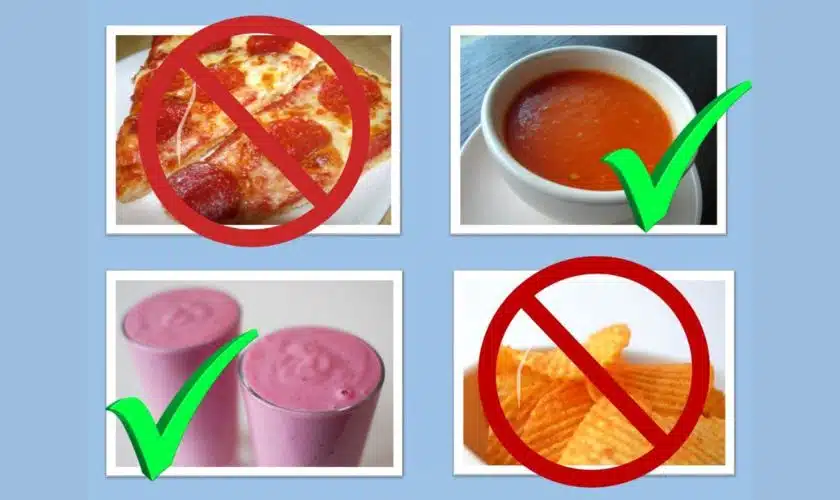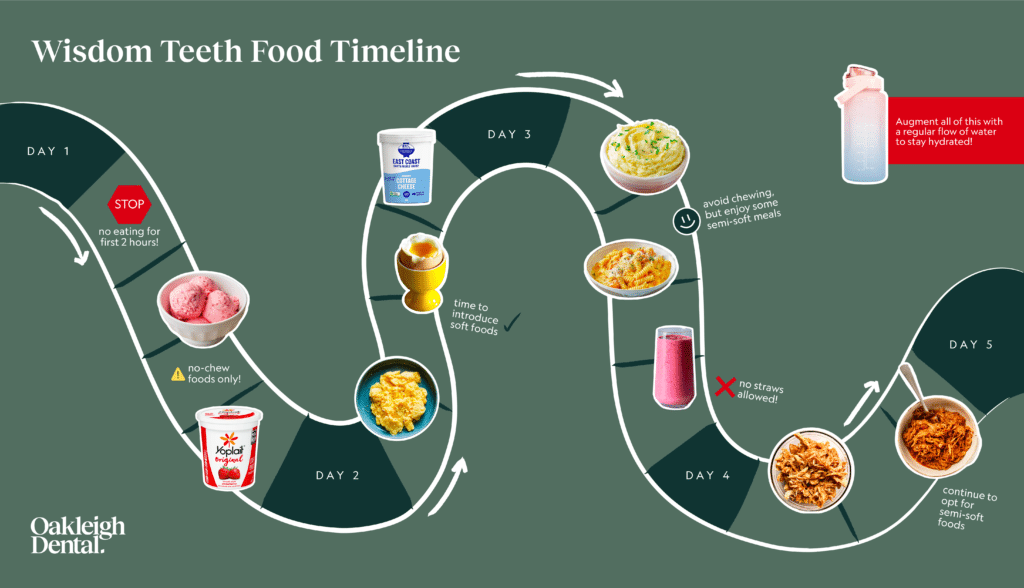You can typically eat solid food after a tooth extraction in about one to two weeks. It’s essential to start with soft foods and gradually reintroduce harder foods.
Dental health is paramount, and after a tooth extraction, what you eat can significantly affect your recovery process. It’s crucial to give your mouth the proper time to heal before jumping back into your regular diet. Eating solid food too soon can disrupt the clotting process, leading to complications such as dry socket.
Starting with liquids and soft foods is generally recommended before slowly reintroducing more solid foods as your extraction site heals. Nutrition should not be neglected during this period, so be sure to consume foods that are both soft and rich in vitamins and minerals to support your body’s healing. Always follow your dentist’s specific instructions on when to resume normal eating habits to ensure a safe and speedy recovery.

Credit: www.oldsettlersdental.com
Understanding Tooth Extraction
Tooth extraction is a dental procedure. It involves the removal of a tooth from its socket in the bone. If you have a tooth pulled, you might wonder about eating solids. Let’s dive into the basics and reasons for this procedure.
The Basics Of Tooth Removal
A dentist or oral surgeon performs a tooth extraction. These experts use special tools to take out a tooth. It’s vital to follow aftercare tips to heal properly. Eating solid food too soon can harm the healing spot.
Why Tooth Extraction Might Be Necessary
A tooth comes out for various reasons. Decay, damage, or crowding can force this decision. Your dental health benefits from this sometimes necessary step. After healing, eating is more comfortable and pain-free.
The Recovery Process
The journey back to enjoying your favorite solid foods begins right after a tooth extraction. It’s important to know when your mouth is ready for a regular diet again. The recovery process determines when to reintroduce solid foods without causing damage or discomfort.
What To Expect Immediately After The Procedure
After a tooth extraction, your body starts healing. It’s crucial to follow a dentist’s advice. Your mouth will be delicate, so care is a must. Expect some bleeding and pain but this is normal. Use gauze pads to control bleeding and apply ice to decrease swelling. Eating can be tricky at first.
- Stick to liquids and soft foods like yogurt, soup, and applesauce.
- Avoid spicy, hot, and chewy foods to prevent irritation.
- Sipping through a straw is a no-go as it can dislodge the blood clot forming in the socket.
The Different Phases Of Healing
Recovery has several phases, each one bringing you closer to your usual diet.
| Time After Extraction | Healing Stage | Food Recommendations |
|---|---|---|
| 24-48 Hours | Initial Healing | Soft foods, no chewing on the side of extraction. |
| 72 Hours Onward | Secondary Healing | Introduction of semi-soft foods like mashed potatoes. |
| 1 Week + | Advanced Healing | Gradually add more solid foods as comfort improves. |
Remember, your healing could be faster or slower than others. It’s important to listen to your body. Signs like reduced swelling, pain, and bleeding indicate you’re on the right path. Regular mouth rinses with salt water can aid the process. Be gentle with brushing around the surgical site.
Initial Post-extraction Care
Initial Post-Extraction Care sets the stage for a swift recovery after having a tooth removed. Knowing when to start eating solid food again is crucial. The right care immediately after surgery helps ensure that your mouth heals properly. Let’s dive into the essentials of post-extraction maintenance.
Managing Pain And Swelling
After tooth extraction, dealing with pain and swelling promptly is vital. Here’s what can help:
- Ice Packs: Apply to the cheek area for 10 minutes on, 20 minutes off.
- Elevation: Keep your head raised with pillows to reduce swelling.
- Medication: Follow the dentist’s instructions for over-the-counter or prescribed painkillers.
Bleeding Control And Clot Formation
Proper clot formation is the key to healing. To control bleeding and encourage clotting:
- Gauze Pad: Bite down gently but firmly on a gauze pad placed by your dentist.
- Rest: Limit activities to avoid dislodging the blood clot.
- Clot Protection: Avoid rinsing, spitting, or using a straw for 24 hours.
Dietary Guidelines Following Tooth Extraction
Recovering from a tooth extraction requires special care, especially when choosing what to eat. Proper nutrition accelerates healing and reduces the risk of complications.
Foods To Avoid Immediately After Surgery
Avoid certain foods that can disrupt the healing process.
- Hard foods: Nuts, chips, or hard candies
- Chewy foods: Gum or tough meat
- Spicy and acidic foods: May irritate the extraction site
- Hot foods and liquids: Can dissolve the blood clot
When To Introduce Liquid And Soft Foods
Start with liquid and soft foods before moving to solids.
| Day After Surgery | Type of Food |
|---|---|
| 1-2 | Clear liquids and no-chew foods |
| 3-7 | Puddings, yogurts, and smooth soups |
| 7+ | Gradual introduction of soft solids |
Eat these soft foods until you can chew comfortably.
Transition To Solid Foods
After a tooth extraction, eating solid foods too soon can cause complications. It’s important to wait until your mouth heals. This part of the healing process varies from person to person. Transitioning to solid foods is a key step in your recovery.
Evaluating Readiness For Solid Food
To determine if you’re ready for solid foods, check for these signs:
- Minimal swelling in the extraction area
- No significant pain when pressing near the site
- The ability to chew without discomfort
Always follow your dentist’s advice on when to reintroduce solid foods.
Types Of Solid Foods To Start With
Once ready, ease into eating solids with these options:
- Soft fruits like bananas
- Scrambled eggs for protein
- Steam-cooked vegetables
- Slow-cooked tender meats
Choose foods that don’t require extensive chewing or can irritate the wound. Make sure to cut food into small, manageable pieces. Take your time with each bite and chew on the opposite side of your mouth from the extraction site.

Credit: oakleighdental.com.au
Role Of Nutrition In Healing
After a tooth extraction, your body needs to heal. Nutrition plays a crucial role in this healing process. The right vitamins and minerals can help reduce swelling, fight infection, and lead to quicker recovery times. It’s not only about when you can start eating solid food, but what types of food can aid in your recovery.
Important Nutrients For Recovery
Consuming the right nutrients is essential for swift healing post-tooth extraction. Your body demands specific vitamins and minerals to repair tissues and reduce inflammation.
- Vitamin C – Aids in wound healing and immune function.
- Vitamin A – Supports cell growth and immune response.
- Protein – Builds and repairs tissue.
- Zinc – Promotes cell growth and immune health.
- Calcium – Vital for bone healing and strength.
Foods That Promote Wound Healing
Knowing which foods aid in repairing your mouth is vital. Soft and nutrient-rich foods should top your diet list right after extraction.
| Food Type | Benefits |
|---|---|
| Smoothies | Vitamins, minerals, and protein without chewing. |
| Broths/Soups | Hydration and nutrients in an easy-to-consume form. |
| Mashed Potatoes | Comforting and packed with calories for energy. |
| Yogurt | Probiotics and protein to support immune health. |
| Scrambled Eggs | Soft texture and rich in protein. |
Incorporating these foods into your diet can help speed up your healing. Always ensure food is cool enough to eat to avoid irritation. Follow your dentist’s advice before introducing solid foods back into your diet.
Complications That May Affect Diet
After a tooth extraction, most patients focus on managing pain and healing quickly. Yet, sometimes complications arise that could affect your diet. Understanding these complications is key to a successful recovery and knowing when to reintroduce solid foods.
Dry Socket: Symptoms And Dietary Implications
Dry socket occurs when a blood clot fails to form or dislodges from the extraction site. It can be quite painful and may slow down healing. If you experience a dry socket, here’s what you should know about your diet:
- Avoid crunchy or hard foods that could irritate the area.
- Stick to soft foods and liquids to prevent further complications.
- Use a straw for liquids to minimize contact with the extraction site.
Symptoms may include severe pain, bad breath, and an unpleasant taste in your mouth. See your dentist if you suspect a dry socket.
Infection: Identifying Signs And Dietary Considerations
Infection is another complication to watch for after tooth extraction. Signs can include swelling, redness, and pus discharge. Diet plays a crucial role in managing an infection.
- Eat vitamin-rich foods like fruits and vegetables to boost immunity.
- Avoid sugary and acidic foods that can aggravate the infection.
- Stay hydrated with plenty of water to help flush out bacteria.
If you observe any signs of infection, it’s important to contact your dentist immediately.
Long-term Care And Maintenance
Recovering from a tooth extraction takes patience and smart choices. Long-term care and maintenance are key to ensure proper healing. In this section, we delve into post-surgery oral hygiene and the significance of regular dental checkups. These steps help maintain a healthy mouth for years to come.
Oral Hygiene After Tooth Extraction
Maintaining oral hygiene after a tooth extraction is crucial for healing. Begin by gently rinsing with warm salt water 24 hours post-operation. Use a soft-bristled toothbrush to clean your teeth. Avoid the extraction site initially to prevent irritation.
- Brush twice a day with a soft brush.
- Floss daily, avoiding the extraction area at first.
- Rinse with saltwater to reduce swelling and pain.
Regular Checkups And Ongoing Care
Routine dental visits are essential for long-term oral health. Professional cleanings and exams help prevent complications. Every six months, or as directed by your dentist, schedule a checkup. These visits catch potential issues before they worsen. Maintain these habits for a healthy mouth.
- Visit your dentist every six months.
- Get professional cleanings to remove plaque buildup.
- Address new oral concerns promptly to avoid bigger issues.
Faqs On Eating After Tooth Extraction
Recovering from a tooth extraction often leads to questions about diet. Patients want to know when they can return to their regular meals. The following sections offer answers to some of the most frequent concerns regarding eating after tooth extraction.
Common Concerns Addressed By Oral Surgeons
- Timeframe for Solid Foods: Most surgeons advise waiting 24 to 48 hours before attempting solids.
- Type of Solid Foods: Begin with soft foods like mashed potatoes or scrambled eggs.
- Chewing Tips: Chew away from the extraction site to avoid irritation.
- Food Temperature: Enjoy lukewarm meals to prevent discomfort.
- Hydration: Prioritize drinking plenty of water to stay hydrated.
When To Seek Professional Advice
If you experience unusual symptoms, it’s time to call your dentist. Below are signs that require a professional’s input.
- Excessive bleeding that doesn’t subside
- Persistent or severe pain after a few days
- Signs of infection, such as fever or swelling
- Difficulty in eating soft foods after the recommended period
Remember: Healing times vary from person to person. Always follow your oral surgeon’s specific instructions after a tooth extraction.

Credit: www.hillcountryoralsurgery.com
Conclusion
Returning to your favorite solid foods post-tooth extraction requires patience and care. Generally, wait for 24 to 48 hours before gradually reintroducing harder foods. Always follow your dentist’s guidance for a smooth recovery. Listen to your body, eat mindfully, and before you know it, you’ll enjoy your usual diet safely.

